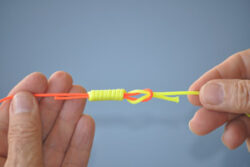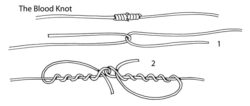Quality fishing line is essential to catching fish. What the fish can’t see is clearly the most important part of your tackle. Premium monofilament has traditionally been a perfect reel to lure connection. Modern lines are a long cast away from the horsehair, sinew, silk, catgut, Dacron, and nylon lines from the past.
Braided lines offer great strength and durability but are not a single filament connection. You still need to add a clear tippet for best results. Braids do work well for some scenarios but an invisible connection to a bait or lure is best. Fish bite best what appears to be free from any line.
Don’t forget to that a great reel with a great drag compliments a great line. The thing to always remember about fishing is that there is never just one thing that is important. There is a tackle box full of things that catch fish consistently.
You can go 2 ways when considering the best single filament lines. First, a clear line that is invisible is a great idea. What the fish do not see won’t scare them. Second, you may want a line that you can see, such as Golden Stren, or a Hi Vis Chartreuse line. Your colored line will also allow you to cast more accurately, since you can see where the line is.
Seeing the line helps the angler see more bites. You still need to add a clear tippet to the colored line but the results of seeing the fish bite before feeling the bite or making the rod bend are huge. The leader to line connection needs to be made using a quality knot, like a blood knot, or a small barrel swivel. If you tie fluorocarbon to Braided line, use an Alberto knot. 
Whether fishing for tuna or trout, it is important to know where your line is so you can avoid contact with snags boats, or other lines. You can also see how and where the line is moving so you can adjust. The Fluorocarbon tippet, or leader, needs to be strong, clear, and hold fast to the hook or lure.
Ideally, you want a single filament line that is small in diameter, durable, ties sturdy knots, and is invisible. For my money, this means Fluorocarbon line. This premium line began as leader material. Japan created this product from a resin called PVDF, or polyvinylidene fluoride. Later it was made to fill anglers full reel spools. The line is virtually clear, thinner, and stronger than other filaments, and has almost the same density as water.
Fluorocarbon lines are more expensive than other lines. They also do not degrade as fast as other lines. This is important when considering their environmental impact. This line is extruded and not pulled from a machine. This means that the diameter of the monofilament can be accurately controlled. If the line is 10 lb. test, it will be 10 lb. test for its entire length. Lines that are pulled from the machine will vary in diameter and strength by a few lbs. either way. 
Fluorocarbon lines also have less stretch than other lines. This lower stretch factor means greater sensitivity. This allows the angler to feel structure and the bottom better. Of course, it also means they feel the bites and strikes better.
Stiffer lines will still tangle but the Fluorocarbon tends to not develop line weakening kinks as easily. Regular mono is lighter than the density of water and is technically a floating mono. It also develops kinks easily, but the kinks are permanent and often weaken the line at that point.
Storing all fishing lines out of the Sun is important. UV rays will degrade most fishing lines. Lines still get damaged when in use or in the rod racks waiting for use. It is a good idea to respool the once a year. In truth, the amount of time used and how the line was used is more important than an annual respooling. Fluorocarbon lines can last much longer.
Rod guides are also something to consider. Nicks and abrasions, caused by fishing lines can be a concern. Line can saw the guides easily. Therefore, quality guides are essential. Friction causes heat which can cause guide damage.
Expense is often why anglers buy line. You get what you pay for and the cost per yard is a concern for some. Bulk spools offer a better value, but you need to store these large spools. A good caster can cast about 30 yards. You can fill the base of a spool with backing, which is cheaper, just in case you need more line. Normally, respooling your reel with 70 yards of fresh mono will be enough for a season of snags, knots, and untangling. Some anglers will reverse their full spools of mono. They tie one end to a fence, then back up until all the line is off the spool. Now they reverse the connection to the spool and rewind.
Fishing lines are always improving. Different lines offer different options as to how you present your baits or lures. Heavy lines may require a different chemistry than finer freshwater lines. A new Fluorocarbon/ mono line, that is more sensitive, retains less memory, and is still thinner with more durability has just hit the market. It is called Seaguar Tatsu.
Tying clean knots, a great drag on a reel, and experience at handling fish will also be a measure as to how a quality line can perform.
Tight lines!
Montana Grant